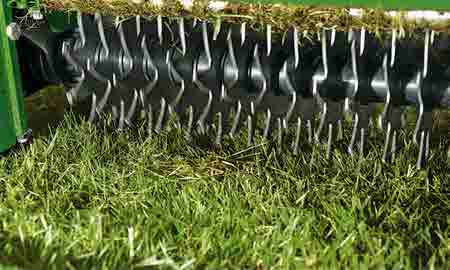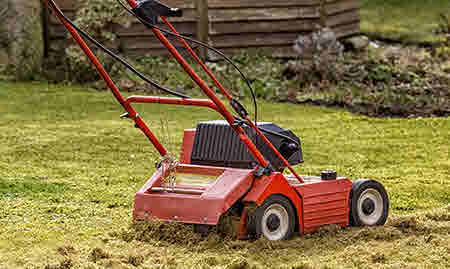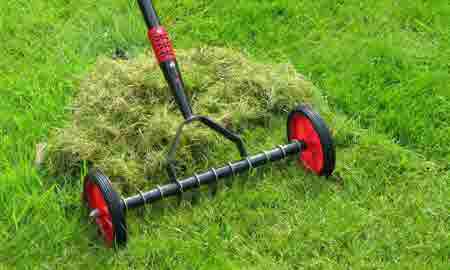Removing Moss from Your Lawn
Moss might seem charming in a fairytale forest, but it’s not so welcome when it invades your lawn. If your grassy haven is looking more like a mossy carpet, it’s time to take action! Removing Moss from Your Lawn – Here’s a step-by-step guide to help you get rid of moss and keep your lawn looking lush and green.
Before diving into the removal process, it’s crucial to understand why moss is thriving in your lawn. Moss typically appears in areas with poor drainage, compacted soil, low pH levels, excessive shade, or insufficient nutrients. Addressing these underlying issues is key to preventing moss from coming back. In this article we are going to go through these steps to help you identify the root problems of your moss problem and then we will provide counter measures to attack the problem.
Steps to Remove Moss from Your Lawn:
1. Assess and Correct the Underlying Issues
- Soil pH: Test your soil’s pH level using a soil testing kit. Moss prefers acidic soil (pH below 6.0). If your soil is too acidic, apply lime to raise the pH.
- Drainage: Ensure your lawn has proper drainage. Aerate compacted soil to improve water flow and reduce moss growth. Below we explain how you can identify and improve your drainage. Important element of the drainage, to ensure that excess water can drain away, is to ensure that soil is not too compact: Aerate is the way to ensure your soil is not too compact.
- Shade: Trim back overhanging branches to allow more sunlight to reach your lawn. Moss thrives in shaded areas.
2. Manually Remove Moss
- Rake It Out: Use a dethatching rake or a garden rake to remove moss from the surface of your lawn. Be gentle to avoid damaging the grass.
- Scarify the Lawn: For larger areas, use a lawn scarifier to remove moss and thatch. This process also helps to aerate the soil.
- A lawn scarifier not a very well-know garden tool, therefore lets explore this a bit further.
- You could describe the Lawn Scarifyer as a rake on steroids. Its proives a lot more force in removing the debris in your lawn.
- A scarifier is a machine that removes the thin layer of old grass stems, dead moss, leaves and other rubbish that gets compacted in your lawn over time. It stops water and nutrients getting to the soil below and stops the grass to grow properly.
- There are multiple machines on the market for this, and you need to select one that would be fitting to the size of your lawn and also how often you need to do this process.



3. Apply Moss Killer
- Choose a moss killer specifically designed for lawns. Look for products containing iron sulfate or ferrous ammonium sulfate. Consult your local garden shop or hardware store to provide you the best local product.
- Follow the instructions on the packaging for proper application. Typically, you’ll need to apply the moss killer on a dry day when no rain is forecasted for at least 24 hours.
- Allow the moss killer to work its magic. The moss will turn black and die within a week or two.
4. Overseed and Fertilize
- Overseed: Once the moss has been removed and the soil prepared, overseed the bare patches with grass seed. Choose a grass seed mix suitable for your lawn conditions.
- Fertilize: Apply a lawn fertilizer to give your grass a nutrient boost. This will help the new grass establish and outcompete any returning moss. Check your local garden shop or hardware store to give you advice on the best lawn fertilizer. Do not use any general fertilizer, but use specific a lawn or grass fertilizer.
5. Maintain Your Lawn
- Regular Mowing: Keep your grass at an optimal height to encourage strong growth and prevent moss from taking hold.
- Aeration: Aerate your lawn regularly to improve soil structure and drainage.
- Fertilization: Feed your lawn with the right nutrients throughout the growing season to maintain its health.
Ensuring the Lawn is well-drained lawn with regular aeration
When you have identified drainage to be one of the root caused for the moss infestation of your lawn, follow these key steps to ensure a step closer to removing moss from your lawn.
How to Drain Your Lawn Properly
- Identify Problem Areas:
- Walk around your lawn and observe where water tends to pool or become soggy after rain. These are your problem areas.
- Improve Soil Drainage:
- Aerate the Soil: Use a garden fork or aerator to create small holes in the lawn, allowing water to penetrate deeper into the soil.
- Add Organic Matter: Incorporate organic materials like compost or sand into the soil to improve its texture and drainage capabilities. This is especially useful for clay-heavy soils.
- Create Drainage Channels:
- French Drains: Dig a trench about 6-8 inches wide and 18-24 inches deep. Line the trench with landscape fabric, add gravel, and lay a perforated pipe. Cover the pipe with gravel and fold the fabric over the top. Fill the trench with soil and grass.
- Simple Drainage Trenches: For less severe issues, you can dig shallow trenches to direct water away from problem areas and towards a more suitable drainage spot.
- Install a Soakaway:
- Dig a Soakaway Pit: Dig a hole about 3 feet deep and 3 feet wide in a location that’s lower than the problem areas. Fill the pit with gravel or other aggregate materials.
- Connect Drainage Pipes: Direct water from problem areas to the soakaway using pipes or channels. This will allow water to slowly filter back into the ground.
How to Aerate Your Lawn Regularly
- Choose the Right Time:
- Aerate your lawn during the growing season when the grass can recover quickly—typically in the spring or fall.
- Select an Aeration Tool:
- Manual Aerators: Use a garden fork or a manual lawn aerator with hollow tines. These tools are ideal for small lawns or spot treatments.
- Powered Aerators: For larger lawns, consider renting a powered aerator from a garden center. These machines make the job faster and more efficient.
- Prepare Your Lawn:
- Water the Lawn: If the soil is dry, water your lawn thoroughly a day or two before aerating. This will make it easier to penetrate the soil.
- Mow the Lawn: Mow your lawn to a shorter length to make aeration easier and more effective.
- Aerate the Lawn:
- Pass Over the Lawn: Use the aerator to create evenly spaced holes throughout the lawn. Aim for 2-4 inches apart. If using a manual tool, push or step down firmly to penetrate the soil.
- Focus on High-Traffic Areas: Pay extra attention to compacted areas, such as spots where people frequently walk or play.
- Post-Aeration Care:
- Overseed and Fertilize: After aeration, overseed your lawn with grass seed and apply a balanced fertilizer. This helps the lawn recover and fill in any bare spots.
- Water Regularly: Keep the soil moist but not waterlogged to encourage grass growth and improve soil structure.
Ensuring the right amount of sunlight
Ensuring your lawn receives the right amount of sunlight is crucial for its health and growth, while at the same time removing moss from your lawn. Here’s a detailed guide to help you manage and optimize sunlight exposure for your lawn:
1. Evaluate Your Lawn’s Current Sunlight Exposure:
- Observe Sunlight Patterns: Spend a few days observing your lawn at different times of the day. Take note of which areas receive full sun, partial shade, or full shade.
- Map Sunlight Zones: Create a simple map of your lawn and mark areas based on their sunlight exposure. This will help you understand which parts need more light and which are adequately sunlit.
2. Trim and Thin Out Trees and Shrubs:
- Prune Overhanging Branches: Identify trees and shrubs that cast excessive shade over your lawn. Trim back overhanging branches to allow more sunlight to penetrate.
- Selective Thinning: Thin out dense foliage to improve light penetration. This involves selectively removing some branches to create a more open canopy.
3. Relocate or Remove Obstacles:
- Move Garden Structures: If possible, relocate sheds, playsets, or other structures that cast large shadows over your lawn.
- Remove Temporary Obstructions: Move any movable items, such as garden furniture or potted plants, that block sunlight from reaching your grass.
4. Optimize Planting and Landscaping:
- Choose Shade-Tolerant Grass: For areas that naturally receive less sunlight, consider planting shade-tolerant grass varieties, such as fine fescue or zoysia.
- Strategic Planting: Plant sun-loving flowers and shrubs in areas that receive the most sunlight, and place shade-tolerant plants in shadier spots.
5. Regular Maintenance:
- Keep Trees and Shrubs Pruned: Regularly trim trees and shrubs to prevent them from becoming too dense and shading your lawn.
- Monitor Sunlight Changes: Continue to observe how sunlight patterns change throughout the seasons. Trees grow and change shape, so periodic adjustments may be necessary.
6. Install Reflective Surfaces:
- Use Reflective Mulch: In shaded areas, use light-colored or reflective mulch to bounce additional light onto your lawn.
- Install Mirrors or Reflective Panels: Place mirrors or reflective panels strategically to direct sunlight onto particularly shaded spots. Ensure they are positioned safely to avoid causing glare or focusing too much heat on one area.
7. Consider Artificial Lighting:
- Landscape Lighting: For areas that still struggle to get enough natural sunlight, consider using landscape lighting. Install outdoor lights to provide supplemental light during the early morning or late afternoon when natural light is insufficient.
Conclusion & Preventing Future Moss Growth
The key to a moss-free lawn lies in consistent care and addressing the root causes of moss growth. With these steps, you’ll be well on your way to transforming your mossy lawn into a green paradise. Remember:
- Regularly inspect your lawn for early signs of moss and take prompt action to address any issues.
- Maintain a healthy, well-drained lawn with regular aeration and proper watering practices.
- Keep your soil pH balanced and provide adequate sunlight by managing shade.
- By carefully managing sunlight exposure, you can ensure your lawn receives the right amount of light it needs to thrive.
- Regular aeration and ensure right drainage.
- Regularly observe and adjust your strategies to keep your grass healthy and vibrant.
Read MoreArticles at FidelDo.com
Other Sites
Links to related articles on other websites worth reading
